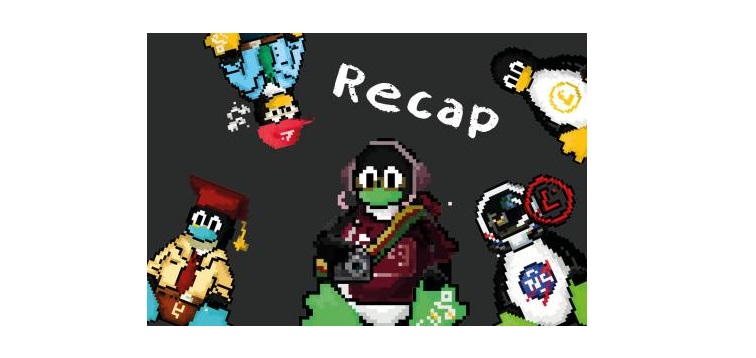Now that the fervor over NFTs is cooling down (or maybe not), this seems like a good time to close off our intern’s recent project.
Over the last summer, a couple of our interns worked on a small exploratory project in order to learn about blockchains, cryptocurrencies, and NFTs specifically. We wanted something that both the IT and marketing interns would find interesting and, for their group project, they decided on creating a Tux variation on the CryptoPunks series of NFTs from scratch. You can read more about what our interns did in their blogs here and here.
At this point, the learning portion of the project is over for the interns but there has been some interest in minting NFTs of the artwork that they created and distributing them in some way that supports LPI’s mission to help foster the adoption of open source. Thus, there is a link to a survey at the end of this article where you, the reader, can add your opinion to the idea of continuing the project.
Why don’t we have consensus on whether to continue this project? Well, the project was interesting and relatively straight-forward to implement at the level of Solidity programming. However, during the project, it became apparent that some people have concerns around the use and viability of cryptocurrencies and NFTs as a technology.
The topmost concerns are that current public blockchain projects are resource intensive (look up the term Proof of Work for some more details on this topic) and can be difficult to make use of by less technically-oriented people. This situation reminds me of the early days of the X Window System and PostScript; slow performance-wise and expensive to implement but with a lot of potential and interesting features. Eventually, hardware and software caught up with X and PS and they’re ubiquitous technologies now.
There are other concerns that people have over the growing use of public blockchains which a reddit user does an excellent job of enumerating in a response to “What’s up with the NFT hate?”. You can read the list of issues in the post’s comments here. I won’t comment on all of them, though. Instead, I’ll focus on the major issues related to our project itself.
People are working on solutions to these problems but they aren’t completely solved yet. For example, the ecological impact of some of the major blockchains is being addressed by switching from Proof of Work to Proof of Stake (PoS) for their consensus mechanism. This should have a great impact on both the hardware and electricity requirements of maintaining a blockchain. Ethereum, the blockchain we used for our project, is expected to complete its transition to PoS sometime this year. In the meantime, many solutions are being developed “off-chain” through the use of layer-2 solutions built on top of the major layer-1 blockchains like Ethereum and Bitcoin. The move to PoS and continued use of layer-2 side-chains are helping to reduce the overall cost of transactions.
Mostly specific to NFTs is the issue of copyright and ownership of the underlying artwork. As Laravel Labs found with their CryptoPunks artwork, they overlooked how to handle the transfer of ownership of their artwork and retrofitted an “NFT license” for owners of the CryptoPunks NFT Short version: People own their NFTs but not the underlying artwork. This solution didn’t appeal to everyone but there are some groups working on the copyright transfer problem. As an example, Alibaba has launched an NFT marketplace that’s using “distributed ledger technology” in order to track and protect copyright claims and transfers.
Then there’s the grifting and fraud that is rampant in the industry. Enough so, that people are writing guides on how to avoid getting scammed by NFT creators and insecure marketplaces. These guides may help but there are also projects underway to make using crypto and owning NFTs easier and less prone to loss. Loopring’s counterfactual wallets and GameStop’s pending NFT marketplace are two examples of attempts to increase the user-friendliness of the technology.
One last concern that I want to mention is the “blockchains are a solution looking for a problem” tenet that some people espouse. I believe the same was said about X and PostScript when they first arrived on the scene (and C++ and HTML and Personal Computers…). With the overwhelming attention paid to NFT sales of cute and colorful cats and apes, it’s easy to think that this is all there is to NFTs and cryptocurrencies. However, there are lots of solutions to real world problems being built on top of blockchain technology. It’s just going to take some time, as well as some major flops and successes, for developers to learn when a publicly viewable linked list with a checksum database helps and when it doesn’t.
Overall, this project was a great success inside LPI. It prompted a lot of discussion about the technology and whether continuing the project is something that’s worthwhile. We didn’t come to a unanimous consensus, though. Some of us want to close off this project and move on to something else to learn. Some of us think that the fun part isn’t over and that we should publish the artwork, complete the NFT contract, mint the NFTs and distribute them amongst our community members.
What we did agree on was that we should ask the LPI community what they think about continuing or ending this project. If you’d like to share your opinion, here’s a short survey which asks for your thoughts overall and on how to handle decisions about the cost of minting NFTs, how to deal with copyright ownership of the artwork, how to share the NFTs, and other concerns.
Source: lpi.org




0 comments:
Post a Comment